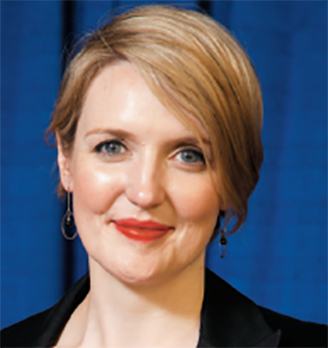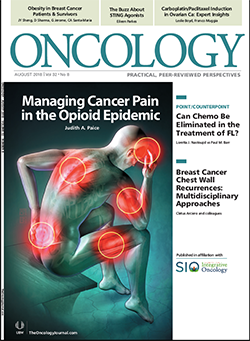Eileen Parkes on Why Cancer Researchers Are Excited About STING Agonists
ONCOLOGY recently interviewed Dr. Eileen Parkes, whose laboratory studies the STING pathway, to find out why researchers are excited about targeting this pathway as a potential cancer therapy.
Oncology (Williston Park). 32(8):402-3.

Eileen Parkes, MD, PhD

STING agonists are a relatively new class of cancer drugs. STING stands for "stimulator of interferon genes." STING is a protein that is part of a signaling pathway that results in upregulation of molecules that are part of the innate immune response. ONCOLOGY recently interviewed Dr. Eileen Parkes of Queen's University in Belfast, whose laboratory studies the STING pathway, to find out why researchers are excited about targeting this pathway as a potential cancer therapy.
1. First, can you tell us what is known about the STING pathway and its role in innate immunity?
DR. PARKES: The STING pathway is such an interesting pathway. This pathway is key to our response to infection. You can think of it as being like the emergency services. So, when our bodies are hit with an infection, it’s the STING pathway that is the emergency first responder. The DNA from an attacking virus or bacteria ends up in the cytoplasm of the cell that is invaded. But DNA doesn't belong in the cytoplasm, so it is detected as foreign by a protein called cGAS [cyclic GMP-AMP synthase], which activates the STING pathway. This leads to interferon production, which is really the alarm call of the cell. The STING pathway turns on the interferon response, then it attracts the first immune cells-natural killer cells-to infected cells, and then it calls in the expert cells-the acquired immune system cells-to let the rest of the immune system know there is a problem.
Interestingly, sometimes the STING pathway also drives a subgroup of autoimmune diseases-such as lupus, for example-by inappropriately recognizing a body's own DNA as foreign. This STING response is also seen in some cancers, where inability to repair DNA results in abnormal DNA in the cytoplasm that is picked up by cGAS, activating STING, which in turn activates the interferon response.
2. What is the evidence that modulating this STING pathway might be a good approach for an anticancer therapy?
DR. PARKES: It's always interesting to see what pathways the cancer itself hijacks, and STING is one of those pathways. We know that cancers are dedicated to their own survival and will use any means possible to bypass the immune system, which, in an ideal world, should destroy all cancerous cells. One of the ways the cancer hides itself is by shutting down the immune response. Given STING's key role in turning on the immune response, being that first responder and turning on interferon, researchers hypothesized that turning on the STING pathway would result in immune activation, stimulating the immune cells to attack the cancer. And this is what has been shown in preclinical models. So, STING agonists have been developed that are injected directly into the cancer, activating the immune cells and the local environment, and hopefully resulting in tumor shrinkage.
3. Are there currently any cancer clinical trials that are testing STING agonists that you could highlight?
DR. PARKES: There are a couple of very interesting trials using STING agonists in combination with immune checkpoint-targeted treatment. Both in the United Kingdom and the United States, there are ongoing or proposed studies of STING agonists alone, as well as of STING agonists in combination with anti-PD-1[anti-programmed death 1] immune checkpoint treatments. We and others had previously shown that you need STING to upregulate expression of PD-L1, the ligand for PD-1. And cancers with high PD-L1 expression, we already knew, are those that are most likely to respond to immune checkpoint blockade. Moreover, given STING's role in turning on the immune system, it's a very neat way of making a cold tumor hot-and that is what an immune response is all about, turning these cold tumor microenvironments with few immune cells into hot microenvironments with many infiltrating immune cells, which then could be "turned up" further using immunotherapies.
Certainly mouse studies of STING agonists alone showed that you got a response not just in the injected tumor site, but also in other tumor sites. Additionally, that response was even better in those preclinical studies with the addition of an immune checkpoint blockade antibody. So, our hope is that giving that spark, a STING agonist, to ignite the immune system, along with immune checkpoint blockade, will improve responses to immune checkpoint agents not just in the injected tumor but in the patient's other tumors as well.
4. Are you and other clinicians thinking about approaches to personalizing STING agonist therapy?
DR. PARKES: Yes, definitely. I think understanding the STING pathway really helps us understand how the cancer behaves in relation to the immune system. Some cancers will hijack the pathway, and keep it on, which not only results in inflammatory tumors with lots of growth factors for the cancer, but also turns on immune checkpoints, meaning that those immune cells can't attack the cancer. So these cancers might be the ones that do well with immune checkpoint-targeted therapy alone. Other cancers will shut down STING completely, and there's been some great work recently showing that cGAS and STING are often methylated, often shut down in cancers. So giving a STING agonist to patients with these cancers may help overcome that immune block, and result in a response to just a STING agonist or a STING agonist along with immune checkpoint-targeted treatment. A limitation of the current STING agonists is the need to deliver them by direct injection into the tumor. But many companies are working on overcoming this by developing STING agonists that can be given intravenously or even orally. There's also some evidence that other systemic agents, such as DNA-damaging treatments, can act as STING agonists too.
In terms of personalized STING treatments, we know already that there is no one-size-fits-all anticancer treatment. Our understanding of the role of the immune system has made a massive difference in our ability to treat cancer successfully. So, improving our understanding and using new drugs like STING agonists will continue to result in improvement-but to provide truly personalized medicine, we need to understand which patients need a single-agent approach and which need a combination, and which patients may not benefit from either. But we haven't yet developed or validated the biomarkers to tell us these things. That's an important goal for the future.
Financial Disclosure:The author has no significant financial interest in or other relationship with the manufacturer of any product or provider of any service mentioned in this article.

Late Hepatic Recurrence From Granulosa Cell Tumor: A Case Report
Granulosa cell tumors exhibit late recurrence and rare hepatic metastasis, emphasizing the need for lifelong surveillance in affected patients.